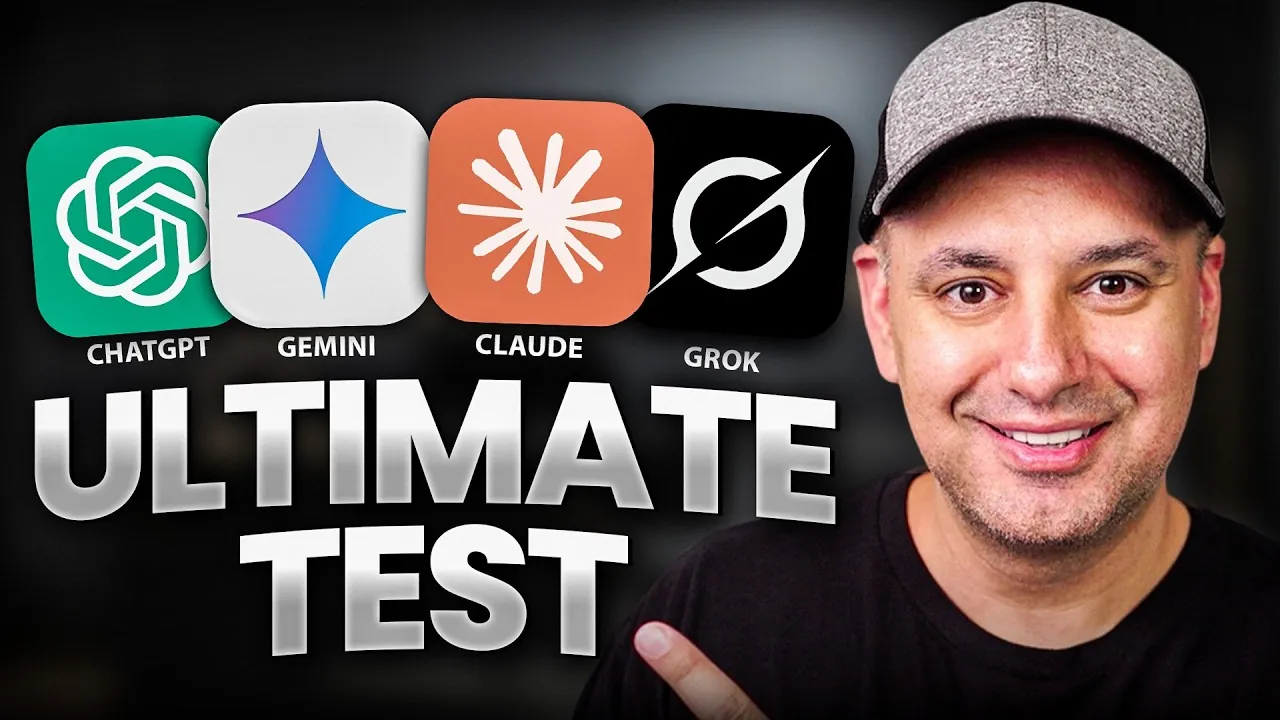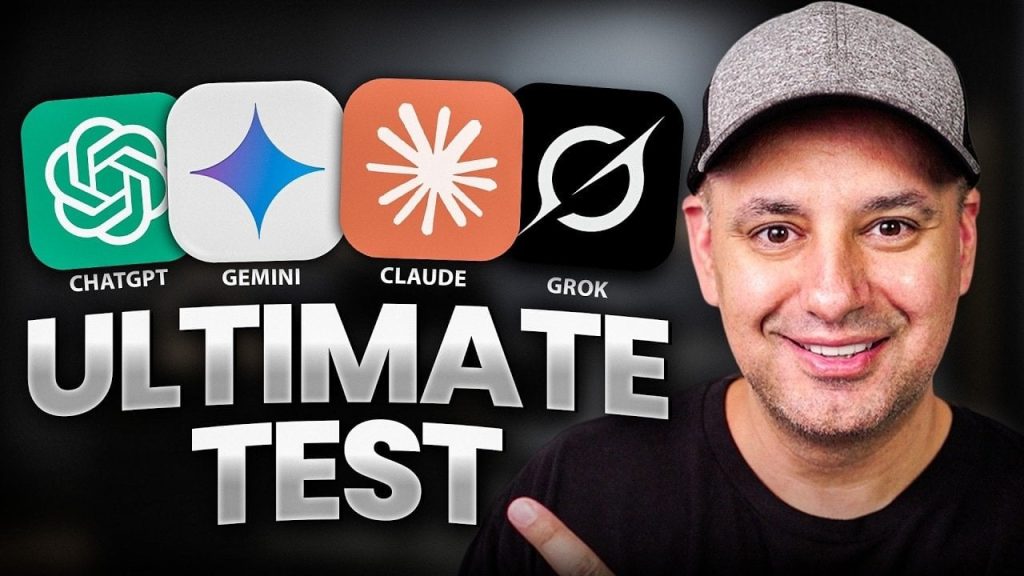
What happens when four of the most advanced AI models go head-to-head in a battle of wits, precision, and adaptability? In an era where artificial intelligence is reshaping industries and redefining creativity, the competition between ChatGPT 5, Gemini Pro, Claude Opus 4.1, and Grok is nothing short of new. Each promises unparalleled capabilities, from solving intricate problems to generating flawless code, but which one truly delivers? This coverage dives into their strengths and shortcomings across critical areas like reasoning, coding, and user interface design. The results might surprise you, especially when it comes to how they handle high-stakes tasks like hallucination detection or business forecasting. If you think all AI models are created equal, think again.
In this comparison, Skill Leap AI uncover how these AI titans stack up against each other in real-world scenarios. Whether you’re a developer seeking precise coding outputs, a business leader looking for reliable decision-making tools, or simply curious about the future of AI, this guide has something for you. From the elegant visual design of Claude Opus 4.1 to the logical prowess of ChatGPT 5 and Grok, each model brings something unique to the table. But as we peel back the layers of their performance, you’ll see that even the most advanced systems have their quirks. The question isn’t just which AI is best, it’s which one is best for you.
AI Model Comparison Guide
TL;DR Key Takeaways :
Reasoning and Problem-Solving: ChatGPT 5 and Grok excel in logical reasoning and multi-step problem-solving, making them ideal for complex tasks, while Gemini Pro and Claude Opus 4.1 show inconsistencies in nuanced challenges.
Coding and Outputs: Claude Opus 4.1 leads in visually polished outputs, while ChatGPT 5 and Grok prioritize functionality. Gemini Pro delivers functional code but struggles with prompt adherence.
Hallucination Detection: All models have improved in avoiding false information, with ChatGPT 5 and Claude Opus 4.1 showing slightly higher accuracy, though occasional errors persist.
User Interface and Presentation: Claude Opus 4.1 stands out for its visually appealing and organized outputs, while Grok lags behind in aesthetics. ChatGPT 5 and Gemini Pro provide satisfactory but less refined results.
Specializations and Use Cases: ChatGPT 5 and Grok are versatile leaders in reasoning and coding, Claude Opus 4.1 excels in design-heavy tasks, and Gemini Pro offers solid reasoning but struggles with execution consistency.
Reasoning and Problem-Solving: The Core of AI Intelligence
Reasoning and problem-solving are fundamental benchmarks for evaluating an AI model’s effectiveness. These skills determine how well a model can handle complex tasks, such as solving intricate math problems or interpreting abstract concepts like the top view of a pyramid.
In standardized tests, ChatGPT 5 and Grok emerged as leaders, demonstrating consistent logical reasoning and accuracy in multi-step challenges. For example, both models excelled in solving advanced logic puzzles and providing clear, step-by-step explanations. On the other hand, Gemini Pro and Claude Opus 4.1 occasionally struggled with nuanced tasks. While Gemini Pro often failed to provide coherent reasoning for its answers, Claude Opus 4.1 showed inconsistencies in handling multi-layered problems.
These findings highlight the varying levels of depth and precision in reasoning capabilities, making ChatGPT 5 and Grok better suited for users requiring advanced problem-solving skills.
Coding and Interactive Outputs: Building Beyond Text
Coding proficiency is a critical feature for users seeking AI models capable of generating functional and interactive outputs. Tasks such as creating websites, solving mazes, and designing spreadsheets revealed distinct strengths and limitations among the models.
Claude Opus 4.1 excelled in producing polished and visually appealing outputs, particularly in tasks like interactive dashboard creation.
ChatGPT 5 and Gemini Pro delivered functional code but occasionally deviated from detailed prompts, leading to inconsistencies in execution.
Grok demonstrated strong accuracy in generating code but lacked the visual refinement and sophistication seen in Claude’s outputs.
These results suggest that while all four models are capable of coding, their ability to meet specific requirements varies. For users prioritizing visual appeal and presentation, Claude Opus 4.1 stands out, while ChatGPT 5 and Grok are better suited for tasks emphasizing functionality.
AI Showdown: Which Model Reigns Supreme in 2025?
Stay informed about the latest in AI Language Models by exploring our other resources and articles.
Hallucination Detection: A Step Toward Reliability
Hallucination detection, or the ability to avoid fabricating false information, remains a critical challenge for AI models. Encouragingly, all four models have shown significant improvements in this area. During testing, they successfully identified and avoided false data in most scenarios, marking a notable advancement in AI reliability.
However, occasional errors still occurred, underscoring the importance of user vigilance. While ChatGPT 5 and Claude Opus 4.1 demonstrated slightly higher accuracy in avoiding hallucinations, none of the models are entirely immune to mistakes. This reinforces the need for human oversight, particularly in high-stakes applications where accuracy is paramount.
Prompt Adherence and Stress Testing: Following Instructions Under Pressure
The ability to follow detailed instructions is a key measure of an AI model’s utility, especially under complex or high-pressure scenarios. Stress tests revealed notable differences in how the models handled intricate prompts:
ChatGPT 5 occasionally overcomplicated instructions, adding unnecessary details to its responses.
Grok struggled with maintaining clarity and organization in its outputs, particularly when faced with multi-step tasks.
Gemini Pro and Claude Opus 4.1 showed better adherence to prompts but sometimes overlooked subtle nuances in the instructions.
These findings emphasize the importance of crafting clear and precise prompts when working with AI models. For users tackling intricate projects, understanding each model’s limitations can help mitigate potential issues.
User Interface and Presentation: Aesthetic and Usability Matters
The quality of user interface and presentation plays a significant role in determining an AI model’s overall usability. Among the four models, Claude Opus 4.1 stood out for its consistently well-organized and visually appealing outputs. This makes it an excellent choice for tasks requiring polished presentation and aesthetic refinement.
In comparison:
Grok lagged behind, offering less intuitive and less visually refined outputs.
ChatGPT 5 and Gemini Pro delivered satisfactory results but lacked the visual sophistication of Claude Opus 4.1.
For users prioritizing aesthetics and usability, Claude Opus 4.1 is the clear leader, while ChatGPT 5 and Gemini Pro remain reliable options for general-purpose tasks.
Follow-Up Prompting: Adapting and Self-Assessing
Follow-up prompting evaluates a model’s ability to adapt to new instructions and self-assess its performance. Interestingly, Gemini Pro demonstrated a unique approach by providing a neutral response when asked to rank its own performance, refusing to declare itself superior. While this showcased a degree of self-awareness, it did not necessarily translate into better performance in other areas.
In contrast, ChatGPT 5, Claude Opus 4.1, and Grok were more direct in their responses but occasionally struggled to adapt seamlessly to follow-up prompts. This highlights the ongoing challenge of achieving true adaptability in AI models.
Math and Pattern Recognition: Precision in Numbers
All four models performed exceptionally well in math and pattern recognition tasks. They accurately solved complex calculations, identified recurring patterns in data sets, and even calculated weekdays for specific dates. This consistency underscores their reliability for tasks requiring numerical precision and analytical thinking.
Prediction and Business Use Cases: Room for Improvement
Business applications, such as revenue projections and market trend analysis, posed challenges for all four models. None fully adhered to the prompts, often making incorrect assumptions or failing to seek clarification when necessary. This limitation highlights the need for human oversight when using AI for business forecasting and decision-making. While the models are capable of providing valuable insights, their outputs should be carefully reviewed to ensure accuracy.
Final Results: Strengths and Specializations
After evaluating the models across multiple dimensions, it becomes clear that no single AI model is universally superior. Instead, each excels in specific areas:
ChatGPT 5 and Grok tied as overall winners, showcasing strong reasoning and coding capabilities.
Claude Opus 4.1 excelled in visual design and user interface tasks, making it ideal for presentation-heavy projects.
Gemini Pro demonstrated solid reasoning but occasionally fell short in execution, particularly in coding and prompt adherence.
Understanding these strengths and limitations can help you select the AI model best suited to your specific requirements. By aligning the model’s capabilities with your goals, you can ensure optimal performance and achieve the results you need.
Media Credit: Skill Leap AI
Filed Under: AI, Top News
Latest Geeky Gadgets Deals
Disclosure: Some of our articles include affiliate links. If you buy something through one of these links, Geeky Gadgets may earn an affiliate commission. Learn about our Disclosure Policy.

